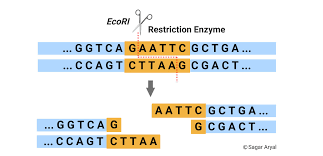Unit 6 AP Bio
1/30
There's no tags or description
Looks like no tags are added yet.
Name | Mastery | Learn | Test | Matching | Spaced |
|---|
No study sessions yet.
31 Terms
How many genes do humans have?
about 20,000-30,000 and it can make about 100,000 different kinds of proteins
Will a cell always express each gene?
No a cell does not always need every protein. During a cells lifetime it will not make every protein because while it has the code for everything it will not need it. Ex. skin cells will not need to produce stomach acids
Gene regulation overview
the way a cell controls which proteins it makes and how much so that it doesn’t waste energy making things it doesn’t need. There are some genes that are always turned on for all cells because they always need it.
Gene expression in Eukaryotic cells
uses regulatory sequences in their DNA for gene regulation (same as prokaryotes)
genes are grouped together and activated by the same transcription factors
complementary genes can be turned on or off together because they are controlled by a single set of transcription factors
Gene expression in Prokaryotic cells
uses regulatory sequences in their DNA
sets of genes are grouped together in units called operons, their genes are usually required at the same time
Operons allow prokaryotes to quickly turn genes on and off in response to their environment
Regulatory sequences (also known as regulatory switches)
stretches of noncoding DNA that interact with regulatory proteins to control transcription
activators and repressors can bind to it and controls the transcription of genes
regulatory sequences do not need to be close to the gene
This includes the promoter and operator
Positive control
positive control is turning on a gene or increasing transcription of a gene
promoter sequences occur upstream (towards the 5’ end) of the gene, activators will bind here so RNA polymerase enzymes can bind and initiate transcription
promoter sequences are usually right next to the gene unlike regulatory sequences and enhancer sequences
Enhancer sequences can occur towards the 5’ or 3’ end of a gene and allow activator proteins to bind to them and interact with transcription factors to promote RNA polymerase binding which sometimes increases the amount of mRNA being made
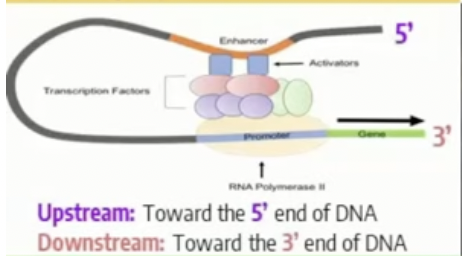
Difference between promoter sequences and enhancer sequences?
Enhancers are short nucleotide sequences that speed up the transcription rate in the genome and they are usually located far away while promoters are fairly large nucleotide sequences that start the process of transcription and are right next to the gene.
negative control
silencer sequences occur either towards the 3’ or 5’ end of a gene and repressor proteins bind to them which stops the transcription of a gene by physically blocking RNA polymerase from binding or transcribing
repressor proteins that bind to the operator prevent RNA polymerase from binding and initiating transcription

What are transcription factors
activators and repressors are examples of transcription factors which are proteins that help with the initiation and regulation of transcription
what is the terminator
spot where transcription ends
What is the operator, promoter, and enhancer region on an operon?
operator - the repressor binds to the operator
promoter - the activator binds to the promoter and RNA polymerase also binds to the promoter but needs the activator so that it can actually copy the DNA
enhancer - activators bound to the enhancer region need mediators so that it can help speed up transcription
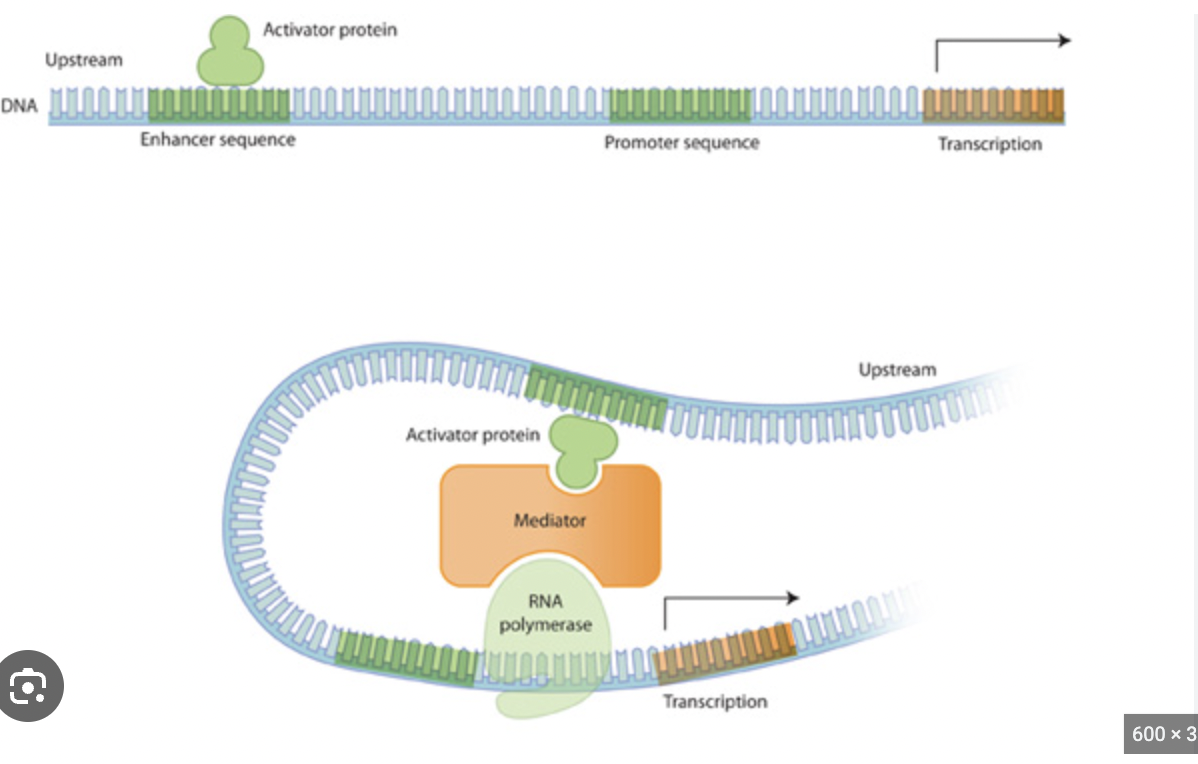
What happens when an inducer molecule binds to the repressor protein?
The repressor protein changes shape so it can not bind to the operator
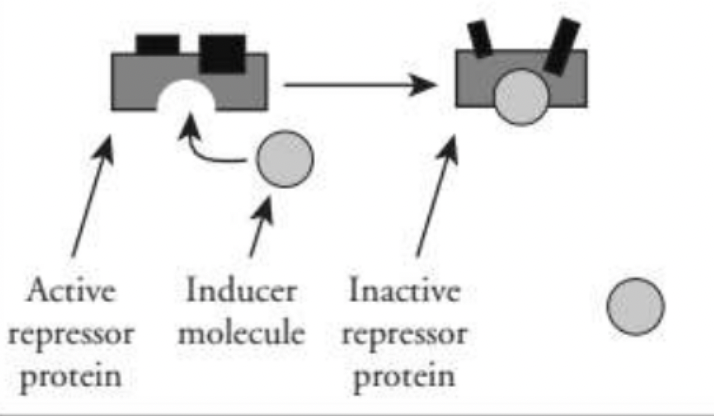
What happens when a corepressor molecule binds to an activator protein?
The activator protein becomes active and binds to the promoter
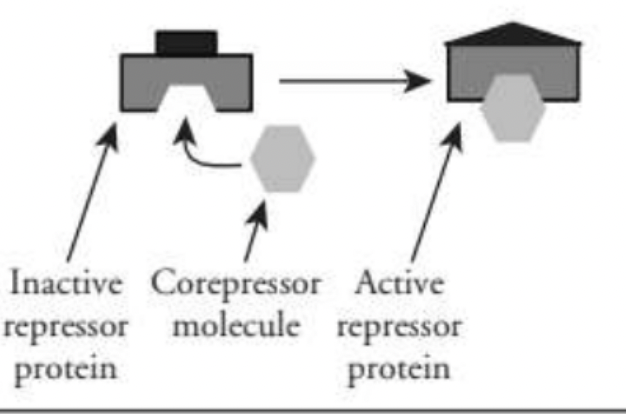
Importance of gene regulations
allows cells to decide how much protein to make in response to the changes in cell environment
allows pluripotent stem cells to develop into the three germ layers (germ layers eventually become different parts of the body) present during vertebrate fetal development (in humans)
later in development it allows for differentiation of specialized cell types in multicellular organisms
all cells have the same DNA so the cell phenotype changes based on what genes that are or are not being expressed and in what amount
Prokaryotic gene regulation
because transcription and translation occur at basically the same time in the same place, gene regulation focuses on transcription by grouping their genes in transcription units (operons)
the genes in an operon are transcribed as a single mRNA sequence but will produce separate proteins because of multiple start and stop codons
There are three types of operons
inducible - a set of genes that are normally turned off unless turned on to maintain homeostasis
catabolic - the breakdown of complex carbs so most inducible operons are catabolic because it only allows for the breakdown of a complex molecule if it is present
Ex. Lac operon - a group of genes that code for proteins that help breakdown lactose and are only activated when lactose is in the environment. Glucose is also prefered over lactose so the genes are only turned on when glucose is in low supply
repressible - genes that are turned on unless turned off in order to maintain homeostasis
anabolic - simple molecules that are bound together to create complex molecules and the produced complex molecule acts to activate the repressor and turn off the operon
Ex. trp operon - controls the production of the amino acid tryptophan. High concentrations of this amino acid will turn of the gene
Constitutively active operons - genes that are always produced to maintain homeostasis “housekeeping” genes

Eukaryotic gene regulation
epigenetics - control of the expression of DNA influenced by its structure so for example DNA can be coiled in a way that makes it more or less accessible by RNA polymerase. This is done by chemically altering the histone protein tails (the proteins that DNA coils around). 2 types of epigenetic tags: Epigenetic tags are also passed down from parents to children and are outside of the DNA but affect its structure
Methylation - adding methyl group to histone tails which causes DNA to wind more tightly, packing the DNA for tightly and making it less accessible to RNA polymerase
Acetylation - adding acetyl groups to histone tails so DNA will be less densely packed and more accessible
pre-transcriptional control - control the production of transcription factors
post-transcriptional control - making mRNA more or less likely to leave the nucleus
translation control - small, non-coding sequences of RNA called microRNA can bind to complementary mRNA sequences and break them down or block translation
post-translational (after proteins are produced) - the proteins may not be assembled and folded so not functional or destroyed immediately after produced.
Evolution of Stickleback
the gene that control pelvic bones are the same for freshwater and ocean stickleback so they have the same protein it is just expressed differently
the gene is turned off in the pelvic region due to a mutation but scientists have identified the switch that turns it on and can remove or add it to control whether the fish grows a pelvic spine.
the same adaptation has occurred in different isolated conditions around the world when the fish were put under the same stress
If repressor on activator on, operon?
off
If repressor off activator off, operon?
off
If repressor on activator off, operon?
off
If repressor off activator on, operon?
on
How does low glucose affect activators and repressors?
When there is low glucose phosphate is removed from ATP making cAMP which activates the activator.
How does a lot of lactose affect activators and repressors?
Lactose will turn off the repressor so that the operon can turn on (If activator is also on) and make the proteins to digest lactose.
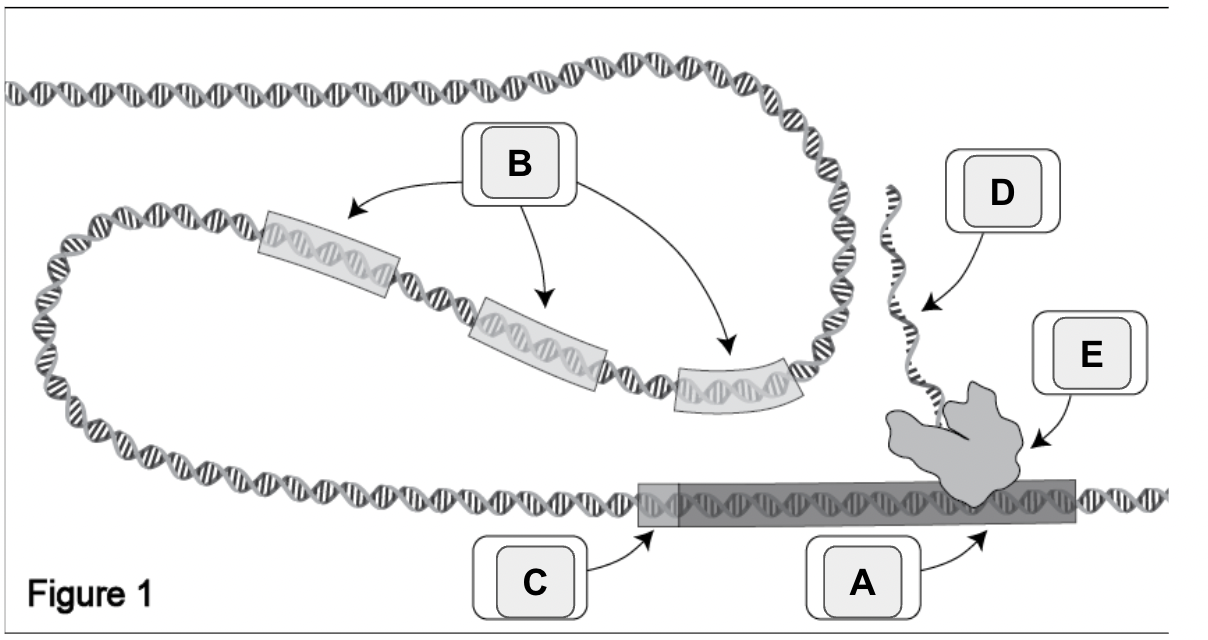
What are the letters in the picture?
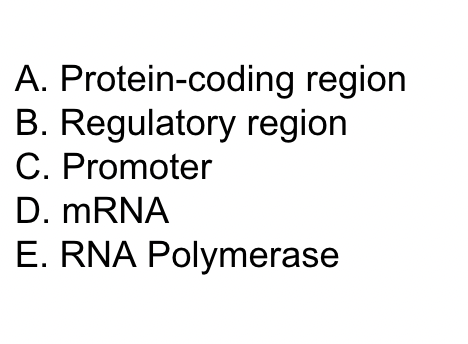
Background for the Biotech lab
LacZ gene codes for the B-gal protein which uses the sugar X-gal to make a blue pigment in e. coli
Cas9 is a protein that can cut DNA but to know where to cut it needs a guide that is complementary to a section of DNA
3 types of horizontal gene transfer for bacteria
Horizontal means it is passed from bacteria in the same generation not from parent to child and it brings more genetic variation
conjugation - bacteria receive DNA from other bacteria that use a sex pilus, this is the most common method
Transduction - uses viruses and usually takes place between the same or related species
transformation - absorbing DNA from the environment, when bacteria die their DNA gets released into the environment which can then be absorbed by other bacteria through the plasma membrane (in the lab we treated the bacteria with heat and added calcium chloride to increase the likelihood of the bacteria absorbing the plasmids). Also mainly takes place mainly between the same or related species
Part one of the Biotech lab: Crispr/Cas9
Crispr was taken from the immune system of bacteria
Experimental:
A plasmid with: a guide RNA that matched the LacZ, a Cas9 protein, and an antibiotic resistance gene was added
Because the guide was complementary to the LacZ gene, Cas9 cut the gene and it got broken apart so it is not functional
because there is no LacZ to make B-gal, the bacteria will be white when spread on a agar plate
we know the transfer of the plasmid was successful because the agar plate was treated with antibiotics so only the bacteria with the resistance gene would survive (this applies to both experimental and control group)
Control
A plasmid with: a guide RNA that does not match the LacZ, a Cas9 protein, and an antibiotic resistance gene was added
because the Cas9 did not know where to cut since the LacZ didn’t match a section of DNA, LacZ was produced as normal
LacZ produced B-gal which produced a blue pigment so so bacteria is blue
Part two of the lab: PCR
Both the control and the experimental go through three steps to make copies of LacZ (if present) and Cas9:
Denaturing - the DNA is separated with heat
Annealing - primers will attach to the separated strands of DNA (in the solution there will be a lot of extra primers to increase the chance of them binding)
Extension - the solution will also have Taq polymerase (works like DNA polymerase but can withstand much higher temperatures) that will attach to the primers and make a lot of copies of the DNA
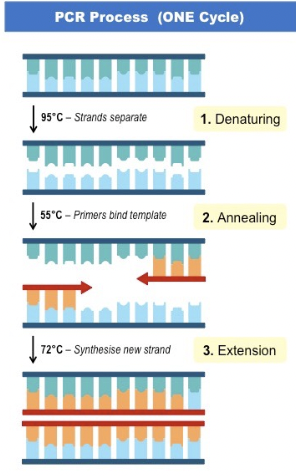
Part three of the lab: gel electrophoresis
A DNA ladder is added to the gel electrophoresis machine that lets us compare the DNA length of the experimental and control group. Smaller pieces of DNA will move further in through the gel.
The Experimental (white colony) DNA will have a line for Cas9 but not for LacZ because it was cut by Cas9
The control (blue colony) DNA will have a line for both Cas9 and LacZ because it had a random guide RNA so the LacZ
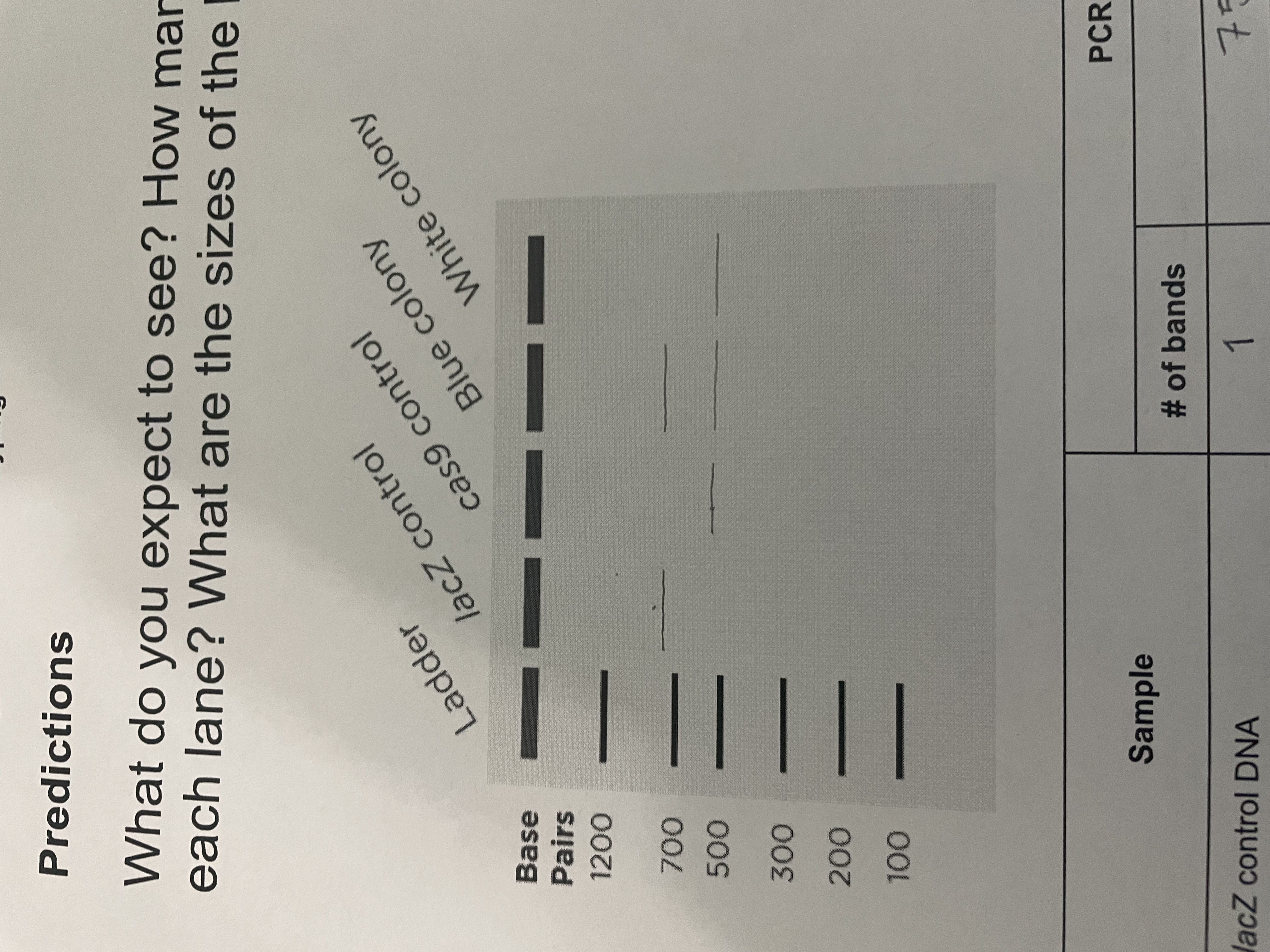
restriction enzymes
proteins that cut both strands of DNA but at an angle which creates sticky ends that can then be combined with different sections of DNA to create recombinant DNA
